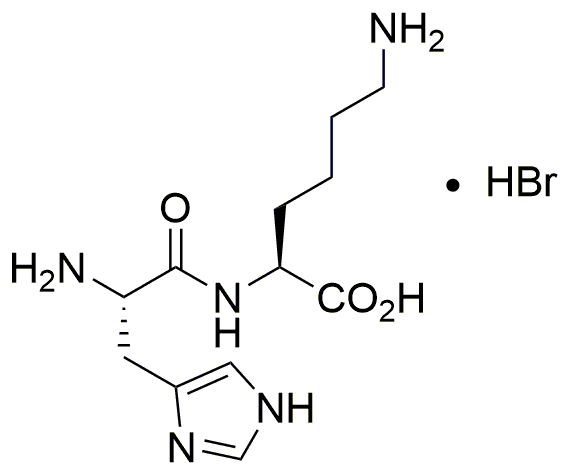H-His-Lys-OH·HBr is widely utilized in research focused on:
- Peptide Synthesis: This compound serves as a building block in the synthesis of peptides, which are crucial for developing new drugs and therapies. Its unique structure allows for the incorporation of histidine and lysine, enhancing the functionality of the resulting peptides.
- Biotechnology Applications: In the biotechnology sector, it is used in the production of recombinant proteins. These proteins are essential for various applications, including enzyme production and vaccine development, providing a reliable source of high-quality proteins.
- Drug Development: The compound plays a role in drug formulation, particularly in creating targeted therapies for diseases. Its ability to modify the pharmacokinetics of drugs makes it valuable in optimizing therapeutic efficacy.
- Research in Molecular Biology: Researchers utilize this compound to study protein interactions and functions. Its incorporation into experimental designs helps elucidate complex biological processes, aiding in the understanding of various diseases.
- Cosmetic Formulations: In the cosmetic industry, it is used in formulations aimed at enhancing skin health. Its properties can improve hydration and skin barrier function, making it a sought-after ingredient in skincare products.
General Information
Properties
Safety and Regulations
Applications
H-His-Lys-OH·HBr is widely utilized in research focused on:
- Peptide Synthesis: This compound serves as a building block in the synthesis of peptides, which are crucial for developing new drugs and therapies. Its unique structure allows for the incorporation of histidine and lysine, enhancing the functionality of the resulting peptides.
- Biotechnology Applications: In the biotechnology sector, it is used in the production of recombinant proteins. These proteins are essential for various applications, including enzyme production and vaccine development, providing a reliable source of high-quality proteins.
- Drug Development: The compound plays a role in drug formulation, particularly in creating targeted therapies for diseases. Its ability to modify the pharmacokinetics of drugs makes it valuable in optimizing therapeutic efficacy.
- Research in Molecular Biology: Researchers utilize this compound to study protein interactions and functions. Its incorporation into experimental designs helps elucidate complex biological processes, aiding in the understanding of various diseases.
- Cosmetic Formulations: In the cosmetic industry, it is used in formulations aimed at enhancing skin health. Its properties can improve hydration and skin barrier function, making it a sought-after ingredient in skincare products.
Documents
Safety Data Sheets (SDS)
The SDS provides comprehensive safety information on handling, storage, and disposal of the product.
Product Specification (PS)
The PS provides a comprehensive breakdown of the product’s properties, including chemical composition, physical state, purity, and storage requirements. It also details acceptable quality ranges and the product's intended applications.
Certificates of Analysis (COA)
Search for Certificates of Analysis (COA) by entering the products Lot Number. Lot and Batch Numbers can be found on a product’s label following the words ‘Lot’ or ‘Batch’.
*Catalog Number
*Lot Number
Certificates Of Origin (COO)
This COO confirms the country where the product was manufactured, and also details the materials and components used in it and whether it is derived from natural, synthetic, or other specific sources. This certificate may be required for customs, trade, and regulatory compliance.
*Catalog Number
*Lot Number
Safety Data Sheets (SDS)
The SDS provides comprehensive safety information on handling, storage, and disposal of the product.
DownloadProduct Specification (PS)
The PS provides a comprehensive breakdown of the product’s properties, including chemical composition, physical state, purity, and storage requirements. It also details acceptable quality ranges and the product's intended applications.
DownloadCertificates of Analysis (COA)
Search for Certificates of Analysis (COA) by entering the products Lot Number. Lot and Batch Numbers can be found on a product’s label following the words ‘Lot’ or ‘Batch’.
*Catalog Number
*Lot Number
Certificates Of Origin (COO)
This COO confirms the country where the product was manufactured, and also details the materials and components used in it and whether it is derived from natural, synthetic, or other specific sources. This certificate may be required for customs, trade, and regulatory compliance.


